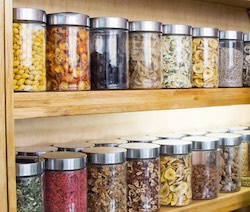Combining acupuncture with a special Traditional Chinese Medicine (TCM) herbal formula relieves perimenopausal insomnia. Acupuncture, as a standalone treatment modality, is found effective for the treatment of perimenopausal related insomnia in a recent study.  However, when a special herbal formula was added to the treatment regime, the total effective rate increased significantly. Researchers conclude that acupuncture combined with herbal medicine “is a simple and effective clinical intervention for the patients with perimenopausal insomnia….”
However, when a special herbal formula was added to the treatment regime, the total effective rate increased significantly. Researchers conclude that acupuncture combined with herbal medicine “is a simple and effective clinical intervention for the patients with perimenopausal insomnia….”
The researchers note that acupuncture combined with the herbal medicine formula Zi Shen Tiao Gan Tang (kidney reinforcing and liver regulating decoction) demonstrates the ability to “regulate endocrine functions” and nervous system functions. The researchers add that the acupuncture plus herbal medicine treatment protocol outlined in the study helps patients “avoid side effects from sedatives” through the use of this effective alternative to drugs. The following are the effective rates, acupuncture points, and herbs used to achieve positive patient outcomes for patients with perimenopausal insomnia.
Effective Rates
The total effective rate for acupuncture combined with Zi Shen Tiao Gan Tang was 96.83%. Using the same acupuncture point prescription without the use of herbal medicine achieved a 74.60% total effective rate. The total effective rate was broken down into three categories: cure, remarkable effect, effect.
A cure was defined as sleep time restoration to normal or sleep time exceeding six hours of sound sleep with the patient being “full of energy” after waking. A remarkable effect was defined as pronounced sleep improvements with an increase of sleep time by three hours. Effect was defined by sleep time increasing to a greater length than prior to the study but less than a three hour improvement. Acupuncture plus herbal medicine achieved a cure rate of 34.92%, a remarkable effect rate of 31.75%, and an effect rate of 30.16%. Acupuncture without the addition of herbal medicine achieved a 26.98% cure rate, a remarkable effective rate of 25.39%, and an effect rate of approximately 22.22%.
Acupuncture Point Prescription
The acupuncture needles were stainless steel filiform needles of size 0.30 x 40 mm. Once the de qi needling sensation arrived, the needles were manually manipulated with moderate needling techniques. The needles were manipulated once every 10 minutes during needle retention time. Total needle retention time was 30 minutes. Acupuncture treatments were given once per day for a total of four weeks to the following acupuncture points:
- Taixi (KI3)
- Sanyinjiao (SP6)
- Baihui (DU20)
- Sishencong (EX-HN1)
- Shenmen (HT7)
- Shenmai (BL62)
- Zhaohai (KI6)
The researchers based the acupuncture point selection on the treatment principles employed for the resolution of perimenopausal sleep disorders: nourish yin, subdue fire, clean the heart, calm the mind, and regulate yin and yang. The researchers note, “All the acupoints in combination can deal with the symptoms and the root causative factors and calm the mind.” The researchers carefully outlined the TCM theoretical basis for each point chosen for inclusion in the study’s design.
KI3 was chosen because it is a yuan-primary acupuncture point that reinforces the kidney, benefits yin, and dredges the meridians. SP6 was chosen because it is a crossing point of the liver, spleen, and kidney meridians that reinforces essence and blood, benefits the liver and kidney, and soothes the liver qi. DU20 (GV 20) was chosen for calming the mind and benefitting the head and eyes. Sishencong was chosen for its ability to “assist Baihui (GV 20) to guide yang into yin and restore the balance between yin and yang.” HT7 was chosen because it is a yuan-primary point and because it tranquilizes the heart and calms the mind. KI6 was chosen for its ability to “nourish yin and reinforce the kidney.”
The Herbs
The herbal formula Zi Shen Tiao Gan Tang was chosen to balance yin and yang “to greatly improve the sleeping quality of the patients.” The ingredients of the formula are:
- Shu Di Huang (Radix Rehmanniae Praeparata) 24 g
- Huang Jing (Rhizoma Polygonati) 9 g
- Bai Shao (Radix Paeoniae Alba) 15 g
- Gou Qi Zi (Fructus Lycii) 15 g
- Tu Si Zi (Semen Cuscutae) 15 g
- Shan Zhu Yu (Fructus Corni) 12 g
- Bai Zi Ren (Semen Platycladi) 12 g
- Fu Xiao Mai (Fructus Tritici Levis) 20 g
- Xiang Fu (Rhizoma Cyperi) 12 g
- Di Gu Pi (Cortex Lycii Radicis) 12 g
- Zhi Gan Cao (Radix Glycyrrhizae Praeparata) 9 g
The herbs were soaked in 500 mL of warm water for 30 minutes. Next, they were decocted by boiling the herbs over a mild fire. After 20 minutes of boiling, the liquid was removed (approximately 200 mL). An additional 300 mL of water was added to the herbs and decocted for another 20 minutes down to 150 mL. The 200 mL and 150 mL portions were combined to form one dose to be taken in two parts, once in the morning and once in the evening on an empty stomach. One dose per day for four weeks was administered.
The researchers note that acupuncture combined with Zi Shen Tiao Gan Tang has a positive therapeutic effect for patients with perimenopausal insomnia. They note that although acupuncture is effective, the combination of acupuncture plus herbs is significantly more effective. Given the positive patient outcomes achieved in the study, the researchers recommend additional investigations into the effects of acupuncture plus herbs for the treatment of perimenopausal insomnia.
Reference:
Tan KP, Yao X, Li XW. Observation on clinical effect of acupuncture plus Zi Shen Tiao Gan Decoction for perimenopausal insomnia. J Acupunct Tuina Sci, 2015, 13 (1): 49-53. DOI: 10.1007/s11726-015-0822-1


